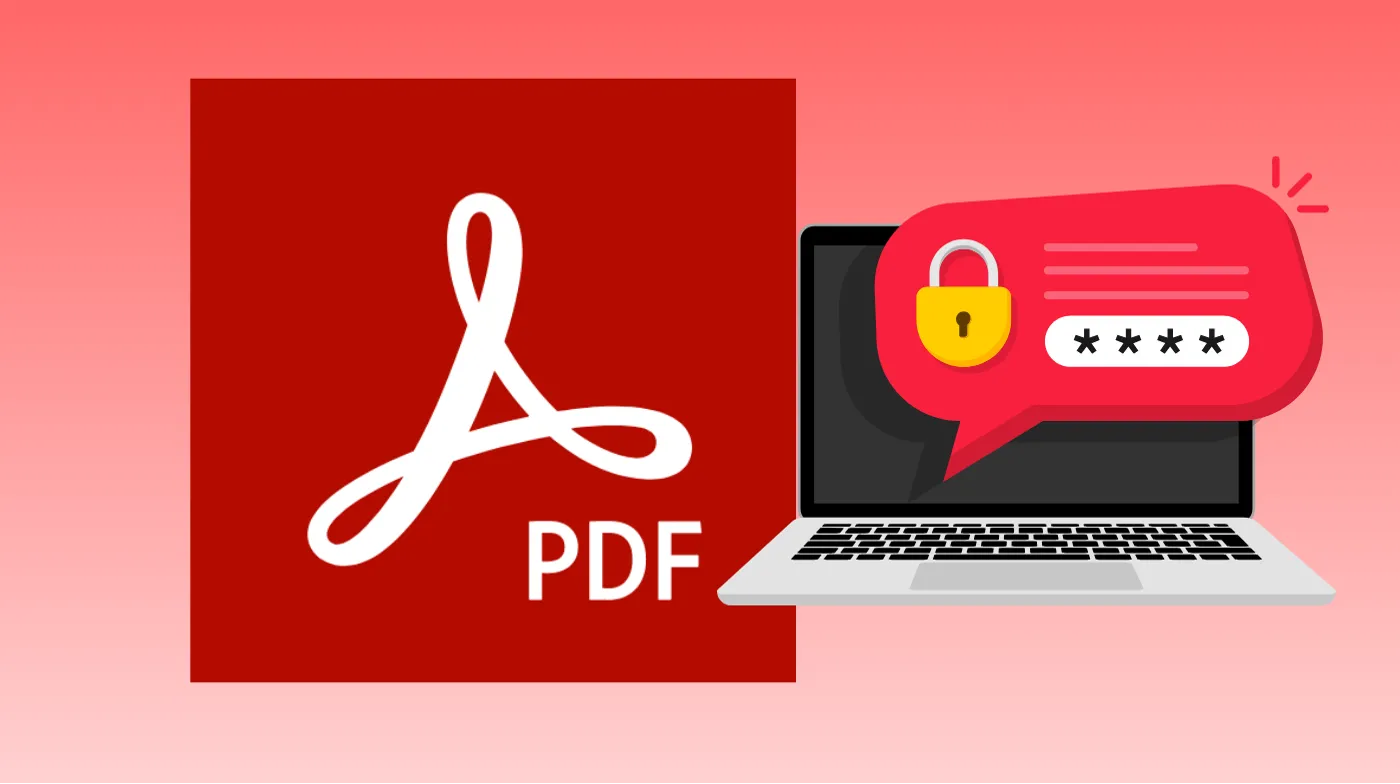
PDF security breaches cost businesses millions annually, yet most professionals don’t properly protect their sensitive documents. Adobe Acrobat’s password protection offers military-grade encryption that transforms vulnerable files into impenetrable digital fortresses.
This comprehensive guide reveals three critical security layers every professional must implement: document open passwords that block unauthorized access entirely, permission controls that restrict printing and editing, and advanced encryption settings that defeat even sophisticated cyber attacks.
You’ll discover step-by-step implementation strategies & master the dual-password system that separates viewing rights from administrative controls. Whether you’re protecting financial reports or confidential business data, these proven techniques ensure your most valuable information remains secure.
The Adobe Acrobat PDF Password Protection
Know about how Adobe Acrobat’s security architecture works and learn the fundamental concepts behind PDF password protection for maximum document safety.
Types of PDF Password Protection Available
Adobe Acrobat offers two distinct password types that serve different security purposes. The document’s open password prevents unauthorized users from viewing PDF content entirely, requiring password entry before accessing any information.
The permissions password allows document viewing but restricts specific actions like printing, editing, or copying content. This dual-layer approach provides flexible security options based on your sharing requirements.
Document Open Password Features
Document open passwords create the strongest security barrier by encrypting entire PDF files using advanced algorithms. Users cannot access any content without entering the correct password first.
This protection method proves ideal for highly confidential documents containing sensitive financial data, legal information, or proprietary business content requiring complete access restriction.
Permission-Based Password Controls
Permission passwords offer granular control over document interactions while allowing basic viewing access. You can restrict printing, content copying, form filling, page extraction, and annotation capabilities.
These settings help maintain document integrity while enabling collaboration, making them perfect for contracts, presentations, or educational materials requiring controlled sharing.
Encryption Strength and Security Levels
Adobe Acrobat employs industry-standard encryption ranging from 40-bit to 256-bit AES encryption depending on compatibility requirements. Higher encryption levels provide enhanced security against brute-force attacks.
Modern versions default to 256-bit AES encryption, offering military-grade protection that would take centuries to crack using current computing technology, ensuring maximum document security.
Setting Up Password Protection in Adobe Acrobat
Master the step-by-step process of implementing password protection in Adobe Acrobat with detailed instructions for both basic and advanced security configurations.
Accessing Security Settings in Adobe Acrobat
Navigate to the “Protect” menu in Adobe Acrobat’s main interface to access comprehensive security options. Click “Protect Using Password” to launch the password protection wizard.
The interface presents clear options for document open passwords and permission restrictions, allowing you to configure security settings according to specific requirements.
Creating Strong Document Open Passwords
Generate robust passwords combining uppercase letters, lowercase letters, numbers, and special characters for maximum security effectiveness. Consider using an online password generator for creating unpredictable character combinations.
Avoid common password mistakes like using dictionary words, personal information, or predictable patterns that cybercriminals can easily guess through automated attacks.
Configuring Permission-Based Restrictions
Select specific permission limitations based on document sharing goals and recipient trust levels. Disable printing capabilities for documents requiring screen-only viewing.
Restrict content copying and extraction to prevent unauthorized redistribution while maintaining collaborative access for legitimate users requiring document review capabilities.
Password Confirmation and Implementation
Verify password accuracy by entering it twice during the setup process to prevent lockout situations caused by typing errors. Save passwords securely using reliable password management tools.
Test password functionality immediately after implementation by closing and reopening the protected document to ensure proper security activation and user experience.
Advanced Security Settings and Encryption Options
Explore sophisticated security configurations including metadata protection, digital signatures, and compatibility settings for comprehensive PDF document protection strategies.
Metadata and Document Information Security
Protect document metadata containing creation dates, author information, and editing history that could reveal sensitive organizational details. Enable metadata encryption to prevent information leakage.
Configure document properties protection to hide file creation software, modification timestamps, and internal document structure from unauthorized analysis attempts.
Compatibility Settings for Different Acrobat Versions
Choose appropriate encryption compatibility based on recipient software versions to ensure proper document access while maintaining security effectiveness. Modern encryption requires updated Acrobat versions.
Balance security strength with accessibility by selecting encryption levels compatible with your audience’s software capabilities without compromising essential protection features.
Digital Certificate and Signature Integration
Implement digital certificates alongside password protection for multi-factor document authentication. Combine passwords with digital signatures for enhanced verification capabilities.
Certificate-based security provides non-repudiation features proving document authenticity and preventing unauthorized modifications while maintaining password-based access control.
Batch Processing for Multiple Documents
Apply consistent security settings across multiple PDF files using Acrobat’s batch processing capabilities. Create security templates for standardized protection across document collections.
Automate password application processes for large document volumes, ensuring uniform security implementation while reducing manual configuration time and potential human errors. Note that when dealing with secured documents, you may encounter restrictions when you try to print a secured PDF, which is an intentional security feature.
Managing and Recovering Protected PDF Files

Learn essential techniques for maintaining password-protected documents including backup strategies, password recovery options, and troubleshooting common security issues.
Password Storage and Management Best Practices
Store PDF passwords securely using dedicated password management applications that encrypt credential databases. Avoid storing passwords in plain text files or browser storage.
Implement password rotation schedules for highly sensitive documents, updating protection credentials periodically to maintain security against potential compromise attempts.
Document Access Recovery Procedures
Establish password recovery protocols for situations involving forgotten credentials or employee departures. Maintain secure backup systems for critical document access.
Consider implementing administrative override capabilities for organizational documents requiring emergency access during security incidents or personnel changes affecting document ownership.
Sharing Protected Documents Securely
Transmit password-protected PDFs through secure communication channels to prevent interception during document distribution. Use encrypted email services or secure file sharing platforms.
Communicate password information separately from protected documents using different communication methods to reduce risks associated with simultaneous credential and document interception.
Remember that even with strong password protection, hackers might attempt to hack email without password using various sophisticated techniques. Given the increasing sophistication of cyber threats, it’s crucial to regularly verify your security measures using email hack checker tools to ensure your accounts remain secure.
Troubleshooting Common Protection Issues
Resolve password authentication failures by verifying character case sensitivity, special character support, and keyboard layout consistency during password entry attempts.
Address compatibility problems between different Acrobat versions by adjusting encryption settings or providing alternative document formats for users with older software versions.
Frequently Asked Questions
Can I Remove Password Protection from Adobe Acrobat PDFs?
Yes, password protection can be removed if you possess the correct passwords. Open the protected document, navigate to security settings, and select “No Security” to remove all protection levels.
Owner password holders can remove both document open and permission passwords, while users with only document open passwords cannot modify permission restrictions without additional credentials.
What Happens If I Forget My PDF Password?
Password recovery options are limited due to strong encryption implementation. Adobe Acrobat doesn’t provide built-in password recovery features for security reasons.
Third-party recovery tools exist but may compromise document security. Prevention through secure password storage using management applications remains the most reliable approach for avoiding lockout situations.
Are Password-Protected PDFs Completely Secure?
Password protection provides strong security but isn’t absolutely unbreakable. Security effectiveness depends on password complexity, encryption strength, and proper implementation of security measures.
Determined attackers with significant resources might eventually crack weak passwords or exploit software vulnerabilities. Combining password protection with additional security layers enhances overall document protection.
Can I Set Different Passwords for Different Security Levels?
Adobe Acrobat supports separate passwords for document opening and permission restrictions. You can use different passwords for each security layer according to organizational requirements.
This flexibility allows document owners to share viewing passwords while maintaining control over editing and printing permissions through separate administrative credentials.
Secure Adobe PDF Documents: Check the Protection Features
Implementing robust PDF password protection represents a critical step in a comprehensive digital security strategy. Adobe Acrobat’s advanced security features provide powerful tools for protecting sensitive information against unauthorized access and distribution.
Success depends on combining technical security measures with organizational policies, user education, and regular security audits. By following these comprehensive guidelines, you can confidently protect valuable documents while maintaining necessary accessibility for legitimate users.
Remember that security is an ongoing process requiring continuous attention to emerging threats and evolving best practices. Stay informed about security updates and maintain vigilant protection of your most important digital assets.
